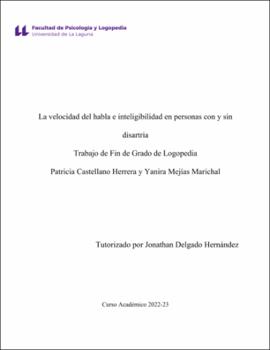La velocidad del habla e inteligibilidad en personas con y sin disartria
Fecha
2023Resumen
La disartria es un trastorno motor del habla, que afecta al control neuromuscular y tiene como
consecuencia alteraciones en la respiración, la fonación, la resonancia, la articulación y la
prosodia.
El objetivo es estudiar la velocidad del habla en personas hispanohablantes con y sin disartria y
examinar la relación entre las medidas acústicas tradicionales de velocidad del habla y la
severidad de la disartria.
En este estudio participaron voluntariamente 30 personas, 15 sin patologías neurológicas y 15
con disartria (5 hipocinética, 5 atáxica y 5 flácido-espástica). Se analizaron 90 muestras de voz, 3
de cada persona. Las frases empleadas estaban fonéticamente balanceadas y con la misma
estructura sintáctica (sujeto, verbo, numeral, objeto y adjetivo).
Las comparaciones entre los dos grupos muestran diferencias significativas en el tiempo de
fonación (p= ,026; d= 0,4), número de pausas (p= ,004; d=,52), tasa de habla (p< ,001; d= 0,70)
y tasa de articulación (p= ,003; d=,53). En la comparación de los tipos de disartria también
existen diferencias significativas, la disartria flácido-espástica presenta una menor velocidad del
habla en comparación a los otros tipos. En cuanto a la severidad existe una correlación positiva
entre la tasa de habla y la tasa de articulación con la inteligibilidad, en el caso del tiempo de
fonación y del número de pausas está correlación es inversa. Dysarthria is a motor speech disorder that affects neuromuscular control and results in alterations
in breathing, phonation, resonance, articulation, and prosody.
The objective is to study the rate of speech in Spanish-speaking people with and without
dysarthria and to examine the relationship between traditional acoustic measures of rate of
speech and the severity of dysarthria.
This study was carried out with thirty people that joined voluntarily. Fifteen of them without
neurological pathologies and fifteen with dysarthria (5 hypokinetic, 5 ataxic, and 5 flaccid
spastic). There were 90 voice samples analyzed, 3 from each person, and the sentences used were
phonetically balanced and had the same syntactic structure (subject, verb, numeral, object, and
adjective).
The results of the comparisons between both groups show significant differences in phonation
time (p= ,026; d= 0,4), number of pauses (p= ,004; d= .52), speech rate (p< ,001; d= ,70) and
articulation rate (p= ,003; d= ,53). There are also significant differences in the comparison of the
types of dysarthria: flaccid-spastic dysarthria presents a lower speed of speech compared to the
other types. Finally, regarding severity, there is a positive correlation between the speech rate
and the articulation rate with intelligibility; meanwhile, in the case of phonation time and the
number of pauses, this correlation is inverse.





